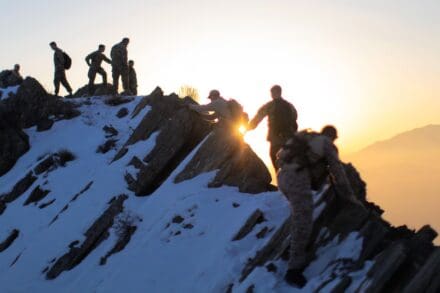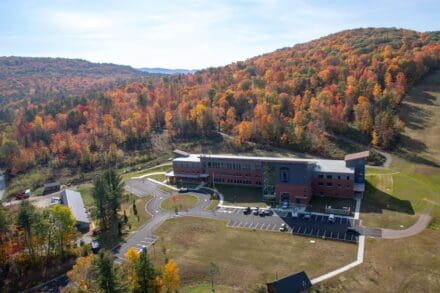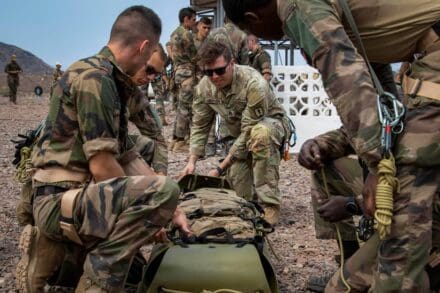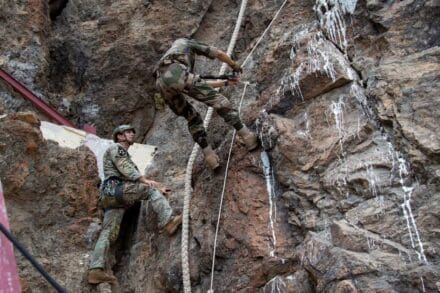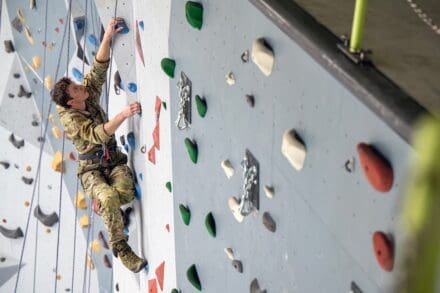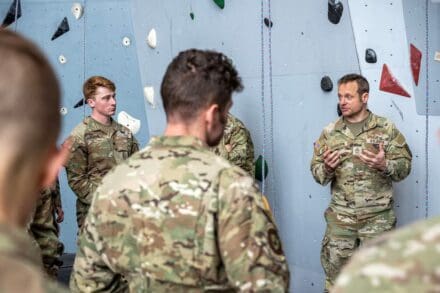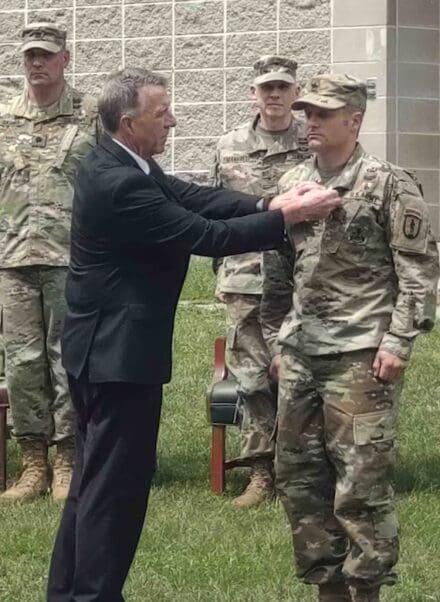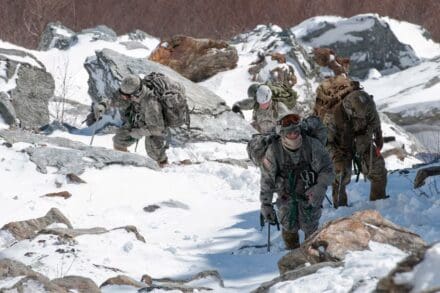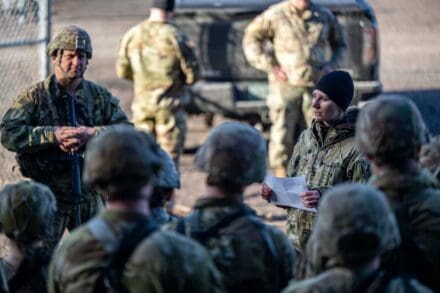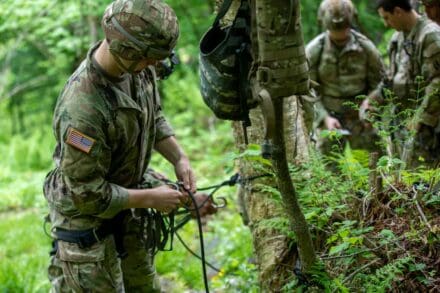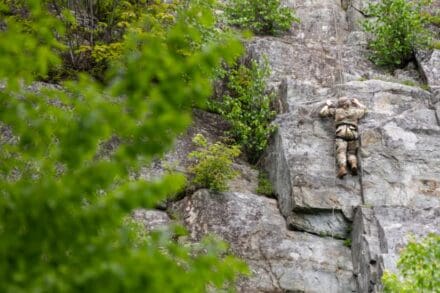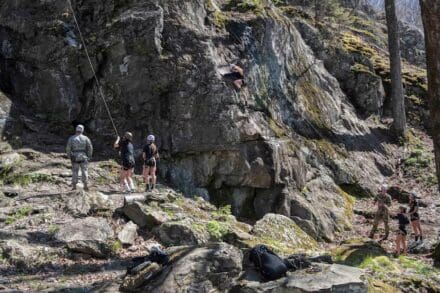From the harsh ridgelines in Italy during World War II and the frigid peaks of Korea during the 1950s, to the Hindu Kush in Afghanistan, mountaineering has long been a necessary skill for U.S. service members in battle. To deter conflicts and defeat aggression, service members need to be prepared to operate in mountainous terrain.
While the Defense Department has a few schools that train students on mountaineering, its main training center for the past 20 years is the Army Mountain Warfare School near Jericho, Vermont.
Operated by the Vermont National Guard, the school trains service members from all branches, as well as foreign militaries and civilian teams looking to learn the latest techniques for rescues and other missions. Training runs from basic to advanced for winter and summer conditions, and some courses focus specifically on training for marksmen and operational planners.
When it comes to the Army Mountain Warfare School’s instructors, students are learning from some of the best mountaineers in the world.
The school has 21 full-time Active Guard Reserve members, 14 of whom are instructors. About three dozen other members of the unit are Guard members and reservists who drill and do their annual training there. Many of those who work at the school have also worked with the 86th Infantry Brigade Combat Team (Mountain), which is headquartered down the hill from the schoolhouse.
The instructors have been through most of the school’s courses themselves, but more importantly, they have years of real-life experience. All of them have civilian mountaineering certifications, and since their military status lets them stay in Vermont long-term, they’re able to constantly hone their skills.
Training Students at Home & Abroad
Outside of the courses they teach to U.S. service members, these instructors are also called upon by partner nations to train foreign special forces units. Army 1st Sgt. Max Rooney said the school has sent teams to Kosovo to train security forces on mountaineering skills. They’ve also exchanged tactics and training with other experts in Austria, Switzerland, Senegal, Italy and other countries, often through the State Partnership Program.
“That’s been a huge part of our training here,” said Army Master Sgt. Bert Severin, the school’s training division noncommissioned officer in charge. “Name a mountainous country and we’ve sent a Mobile Training Team there, either to work with their mountaineering instructors or to teach there.”
Army Maj. Brad Patnaude, the school’s operations officer in charge, said their instructors get invited to more mountain-related exercises than they have the time and funds in which to participate. The courses they teach at the schoolhouse are their major focus.
“The instructors here are amazing. They’ve given us plenty of knowledge,” said Army Staff Sgt. Stephen Vigo, a recruiter with the Connecticut National Guard who took the basic military mountaineer course in March.
Just like their students, the instructors themselves are always learning because mountaineering techniques, strategies and equipment are constantly evolving, as are the terrain, weather and students. For many of the instructors, that’s what makes it exciting.
“It’s a constant struggle to try to manage risk while at the same time putting out the best possible product for the students,” said Army Sgt. 1st Class Dustin Dearborn. “That requires us to be pretty dynamic in our approach. I think that challenge is what really draws me to working here.”
Resident Experts, Local Heroes
Perhaps no one is as experienced or qualified in the DOD mountaineering community than Dearborn — at least, that’s according to his fellow instructors, who all put him at the top of the heap when it comes to mountaineering expertise.
Dearborn grew up as an avid outdoorsman not far from the school’s training site, which made for a natural transition to him joining the school as an instructor in 2001. Since then, his experience has been called upon numerous times to help with local rescue operations over the years.
One involved the rescue of two skiers in 2020 who had ventured into the backcountry near Stowe Mountain Resort. The brothers got lost at night in deteriorating weather and ended up at the top of an ice climbing route. One of them fell off the 220-foot cliff. The second remained stranded at the cliff’s plateau but couldn’t make his way back to safety due to the deep snow, so he called for help. Local rescuers who responded couldn’t access the victims, so they called Dearborn, who led a team of five National Guard soldiers on a mission to reach them.
“We know the terrain pretty well. It’s our backyard,” Dearborn said. “We know the little places to sneak through.”
The rescue required Dearborn to conduct multiple risky climbs at night, including a climb up 200-feet of sheer ice. Eventually he reached the skiers, and he and his team were able to lower both victims to a recoverable position.
In June 2021, Dearborn was honored for his efforts with the Soldier’s Medal, the highest award a soldier can receive outside of combat. When asked about the accolade, Dearborn minimized it, saying he was just doing what he was trained to do.
“The Army has invested a ridiculous amount of time and money to send me to courses and to give me the training and experience to be able to do that,” he said. “It would be ridiculous, I think, if — at this point I couldn’t help in that way.”
Dearborn said rescues are something school instructors help with quite often, especially in areas like Smugglers’ Notch, a narrow pass through the Green Mountains that sits between two local ski resorts.
“We’ve [rescued] lots of snowboarders and skiers that have hit trees or tweaked knees and legs,” Dearborn said. “Conveniently, we’re there, and we have the equipment and the personnel and the training, so it’s easy for us to snatch them up before other folks have to get involved.”
Army Staff Sgt. Andrea Okrasinski is one of the few instructors not native to Vermont. Originally from Illinois, the outdoor enthusiast signed up for the Army Reserve at 18 and spent more than a decade serving as a construction engineer and in civil affairs. But when she attended the AMWS in August 2021, she realized that teaching mountaineering was her true passion. She began the process of transferring over, and in June 2022, arrived at the school to start her new career as a full-time instructor.
Okrasinski said that, aside from having the physical mountaineering skills, instructors need to be able to know how to drive, motivate and mentor students.
“It’s very selective here, which I think is a good thing for the Mountain Warfare School to have —that need to bring a specific skill set and a specific demeanor,” she said. “Safety is a huge [priority] and having that attention to detail for it is really important.”
Why Vermont?
The school’s instructors said they often get asked why they’re based in Vermont and not, say, Colorado’s Rocky Mountains or some other well-known mountainous region. They said the answer is pretty straightforward — their Vermont location is compact, offering a microcosm of everything a mountaineer in training might need to learn in a two-week span.
“We have every training site within 2 miles or 3 miles from here. We have cliffs. We have low elevation as far as altitude … so there’s no climatization needed, whereas in Colorado, that might be an issue. Same thing with the Marine Corps school. They’re at what’s considered a medium altitude, so you have to acclimatize when you get there. Here, you don’t have to,” Severin said. “Everything’s right here — a one-stop shop.”
Those who pass the basic military mountaineer course earn the coveted Ram’s Head Device and the military mountaineer additional skill identifier known as the echo identifier. Two other mountaineering schools also grant the echo identifier — the Northern Warfare Training Center in Delta Junction, Alaska, and the Fort Moore Troops School at the 5th Ranger Training Battalion in Dahlonega, Georgia.
But, according to Severin, the AMWS is more involved in writing the course’s program of instruction, also known as POI, and the material to teach the course. Severin said Alaska’s students are mainly stationed in that state and train on terrain that’s more glaciated, with a focus on tactics for the Arctic as opposed to Vermont’s alpine-style environment.
The Marine Corps Mountain Warfare Training Center near Bridgeport, California, also teaches mountaineering; however, Severin said its students focus more on tactics performed as a unit instead of individually.
The AMWS sees a lot more students come through its doors as well. Officials said they train about 600 students a year, whereas the other schools see up to about 100 for certain specialties.
Keeping Busy
When courses are in session at the AMWS, instructors tend to work 10-12 hours per day, so finding the right work-life balance is sometimes the hardest part of the job.
“We’re here a lot. We have a lot of courses. We don’t have a ton of time between courses to take our leave, so the amount of laundry that’s piling up right now is getting a little ridiculous,” Okrasinksi joked.
For most of the instructors, it’s the close-knit community they’ve formed that keeps them all coming back day after day.
“We trust each other. We respect each other. We work together and play together and fight with each other and, you know, we listen to each other,” Dearborn said. “And I think it’s a rarity in or outside of the military to have that kind of situation.”
By Katie Lange, DOD News


